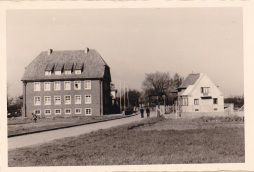City history: 'The city's prime piece of land'
Bocholt's city archive looks at the history of Ritterstraße in the "Photo of the Month" series this time
The Bocholt city archive is looking at the history of Ritterstraße in its monthly series of topics to mark the 100th anniversary of its construction. A street that is particularly notable for its changing names and its urban location. In 2007, an architect once described the street as a " fillet of the city".
At the request of master carpenter Jacob Seesing, the town council approved the construction of a new road north of the town on 31 August 1897 and named it Ritterstraße. At the time, the applicant's business and residential premises already existed on the new connecting road between Herzogstraße and "Chausee Dinxperlo to Bocholt". According to plan, the fully paved and lantern-lit road was to be completed as early as 1899, otherwise the city would complete it at the applicant's expense.
However, delays in the planning and approval process meant that even in 1927, Ritterstraße "was still not completed in accordance with the building regulations for public transport and development [...]." The neighbouring development of this thoroughfare began in 1924 with the planned group of residential buildings by architect Ludwig Beier, surveyor Karl Büschlepp and city building supervisor Richard Unger. The progressive settlement of the street also led to the successive expansion of the street.
From then on, Ritterstraße was regarded as the home of Bocholt's upper administrative and artisan classes. Reason enough for Lord Mayor Dr Schmitz to announce the renaming of the street to "Schlageterstraße" at the city council meeting on 21 May 1933. The reason for this was the nationwide commemorations held on the same day in honour of the former resistance fighter Albert Leo Schlageter, who was instrumentalised by the National Socialists as a "martyr". The street was renamed Ritterstraße again in 1946. A proposal by the SPD in 1979 to rename Ritterstraße to Gustav-Krüger-Straße was unanimously rejected due to large protests by those in favour, which is why the street has retained its original name to this day.
The photo shows Ritterstraße as it was in March 1950, looking towards Herzogstraße. In the foreground is the so-called Behördenhaus, built in 1927 (No. 5 / Auf der Recke junction), which was used by several authorities, first by the land registry office and from 1 March 1939 by the public health department.



